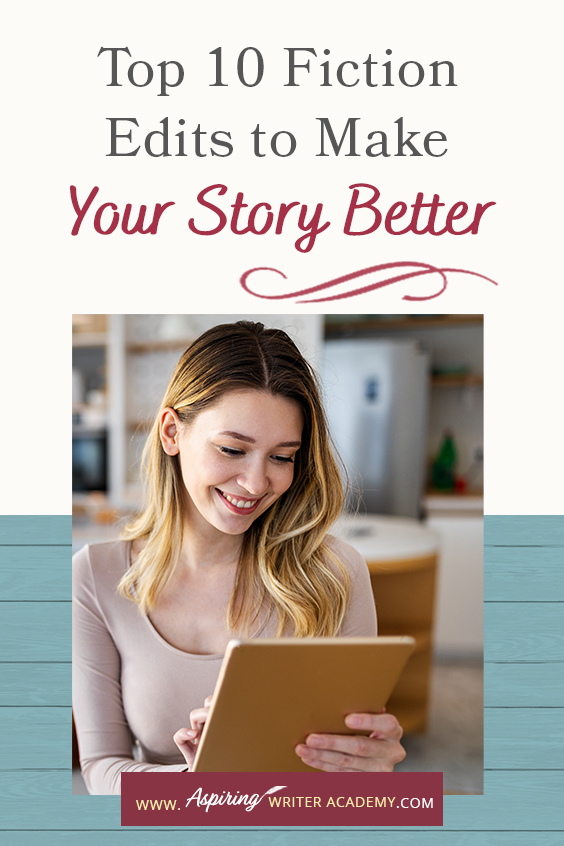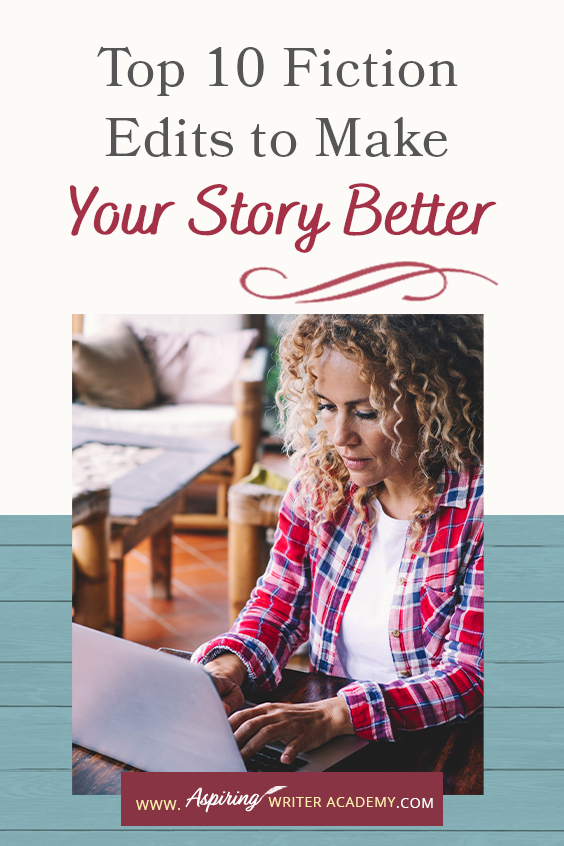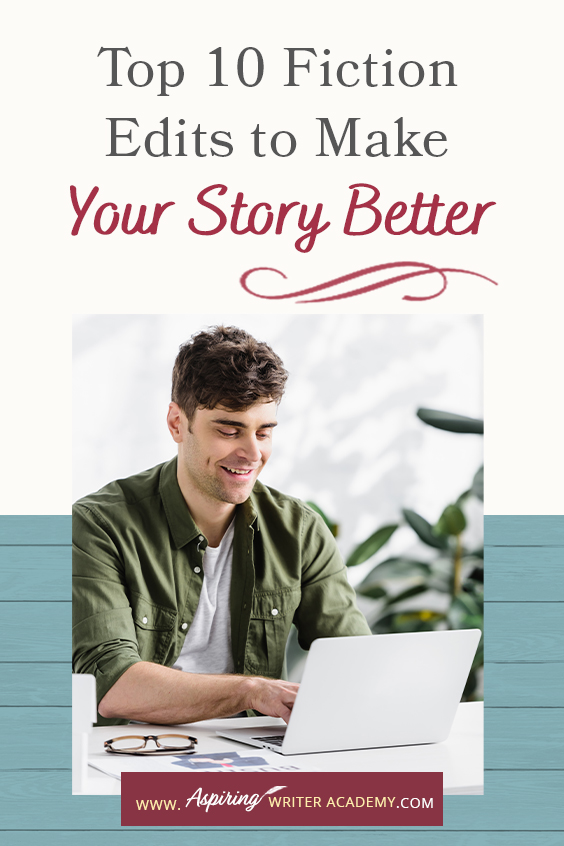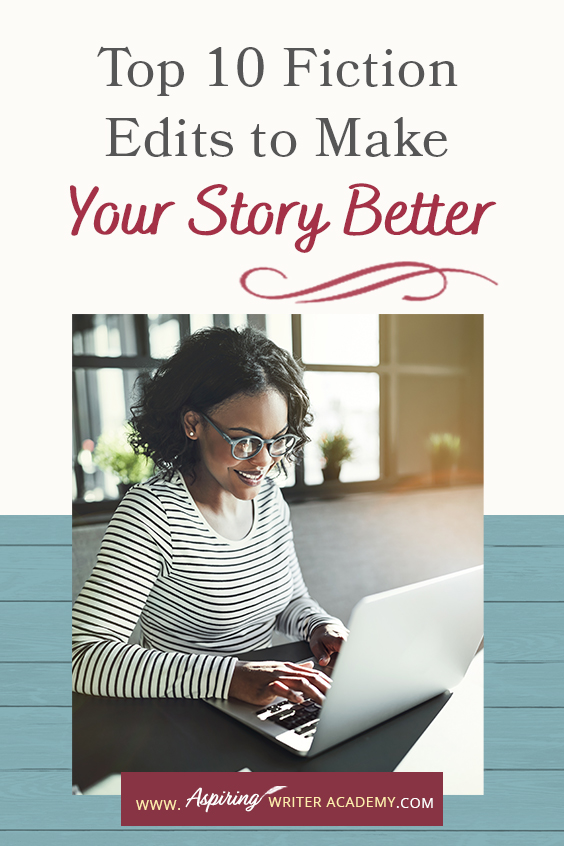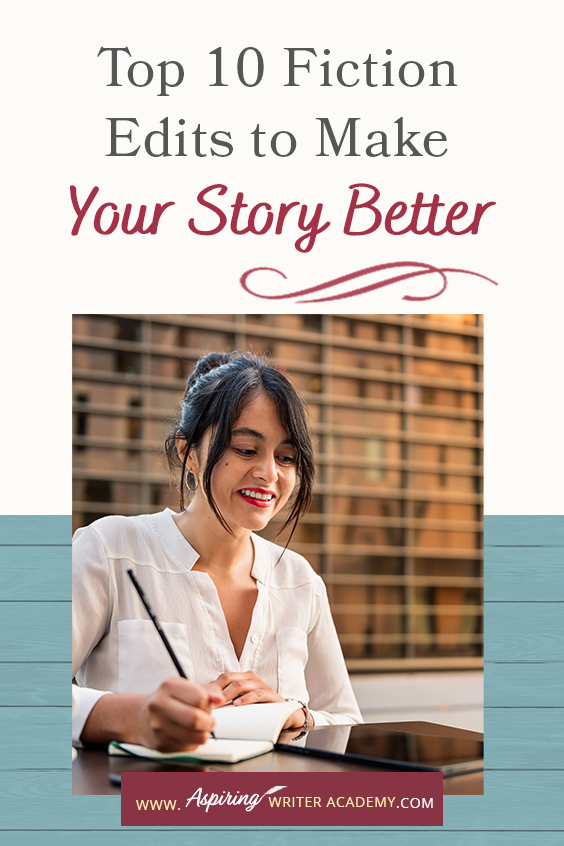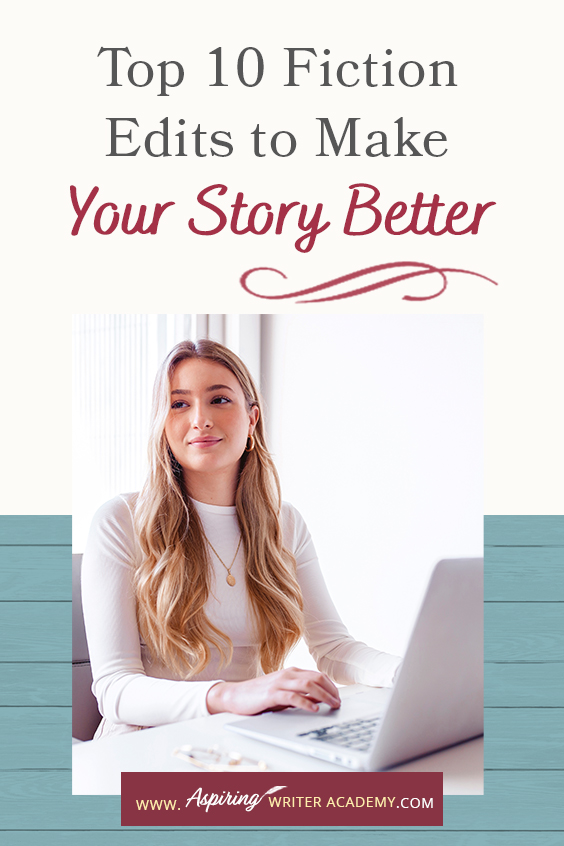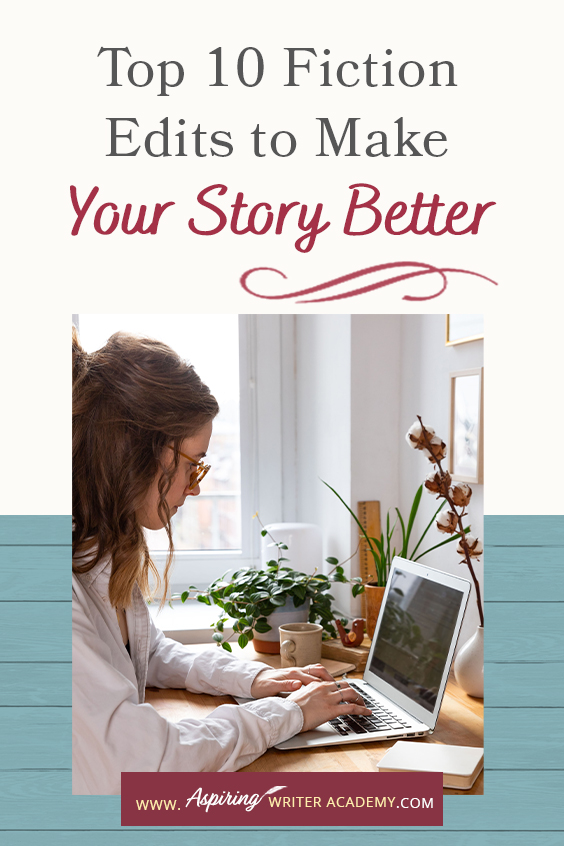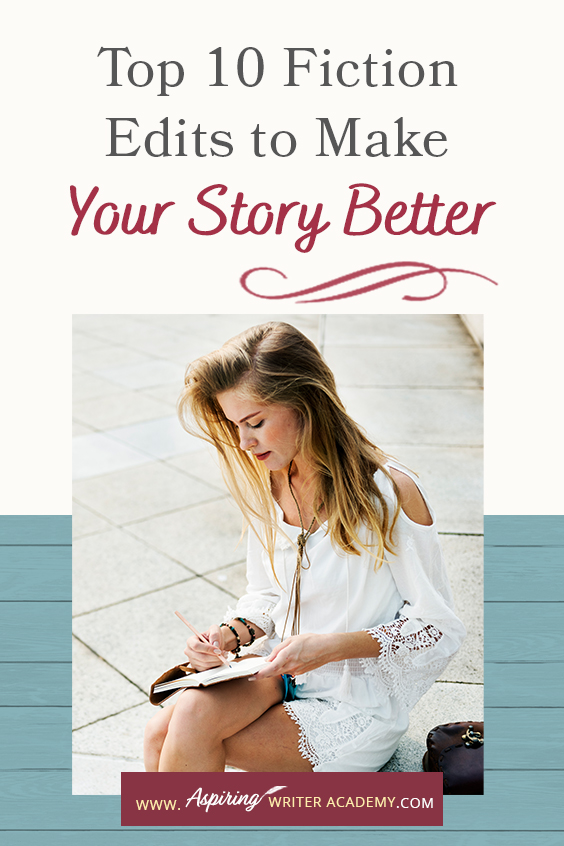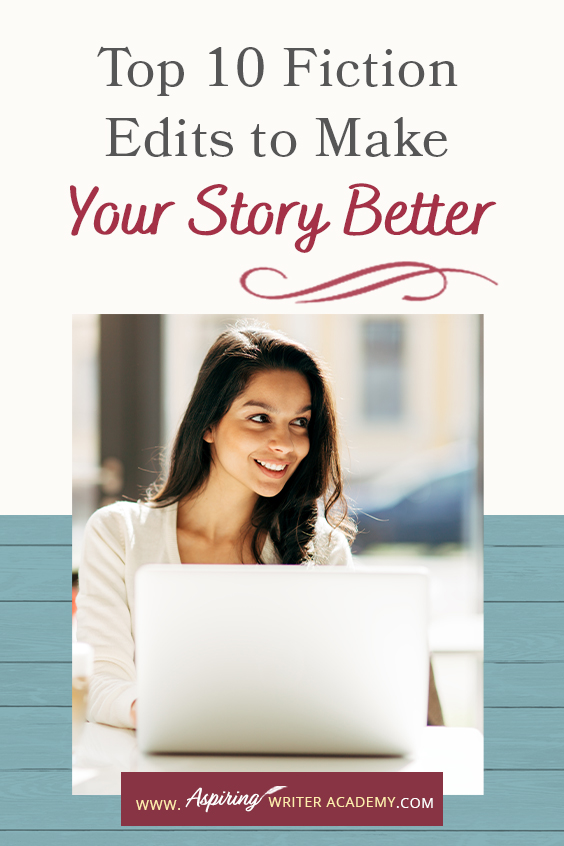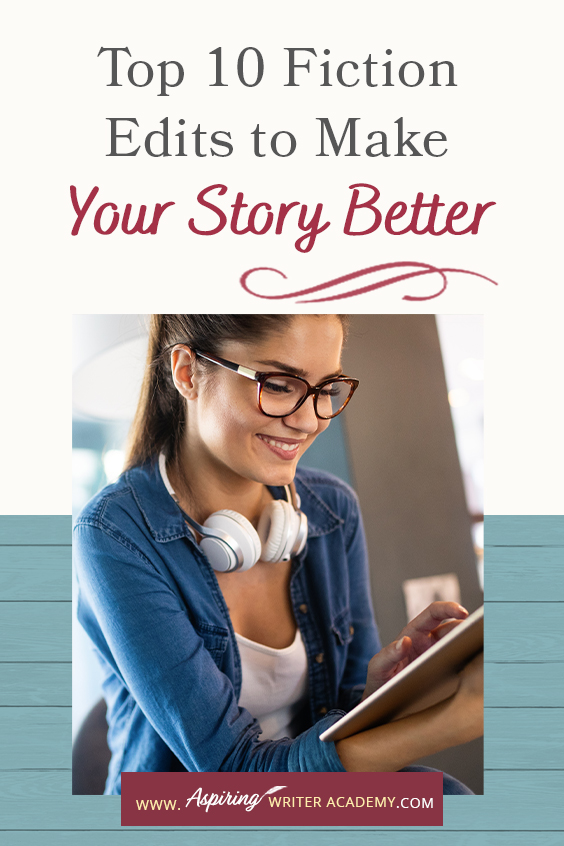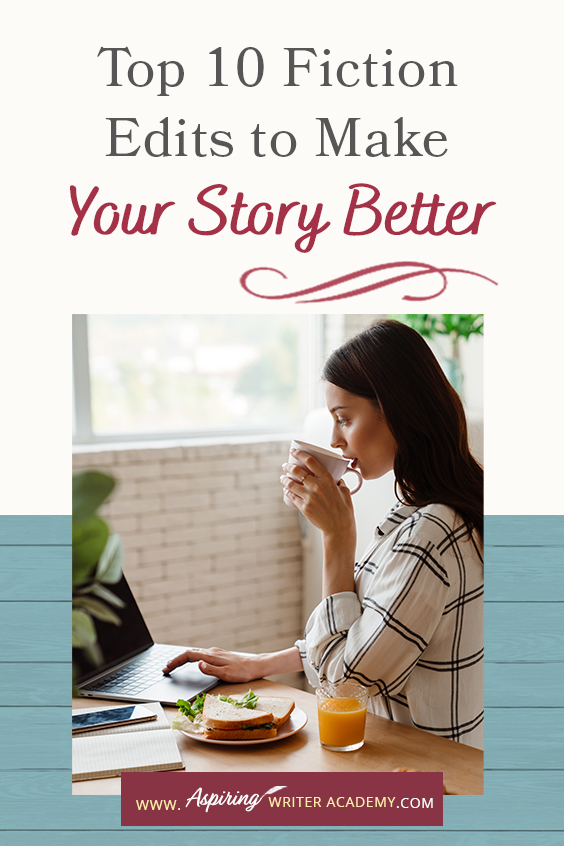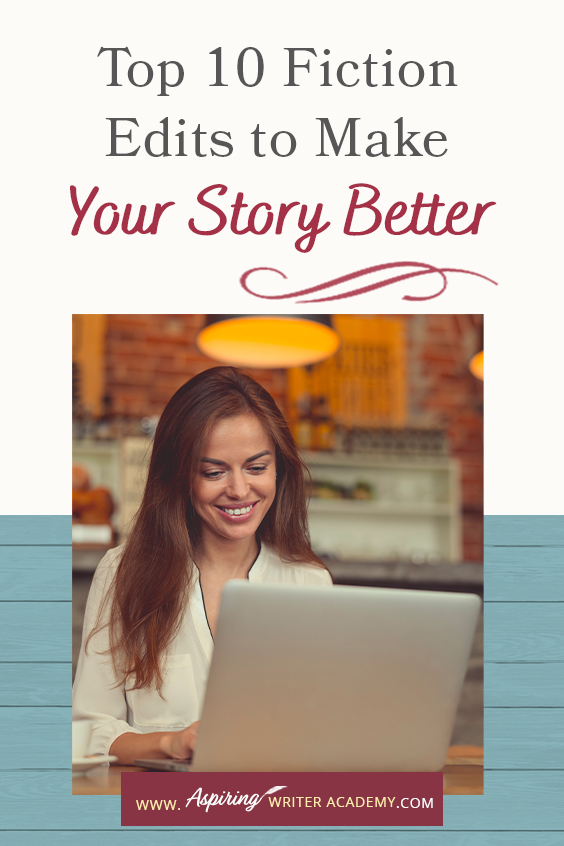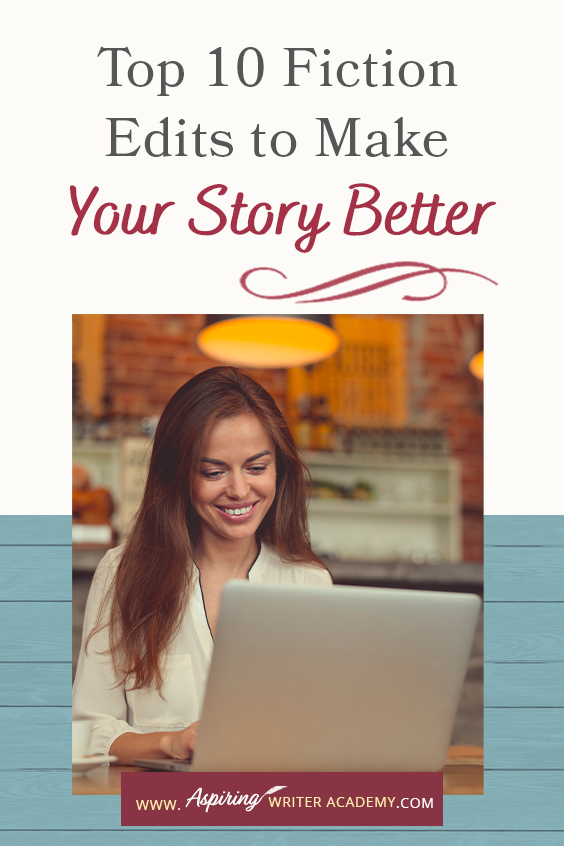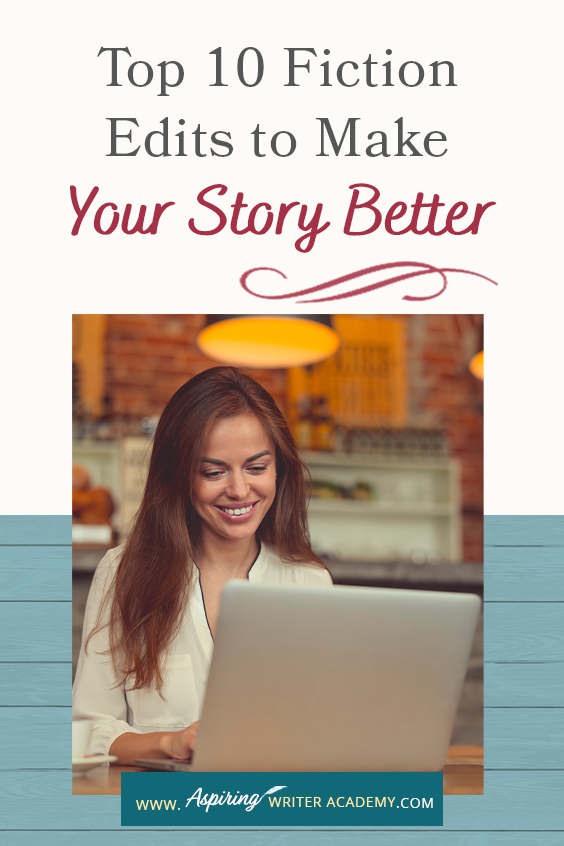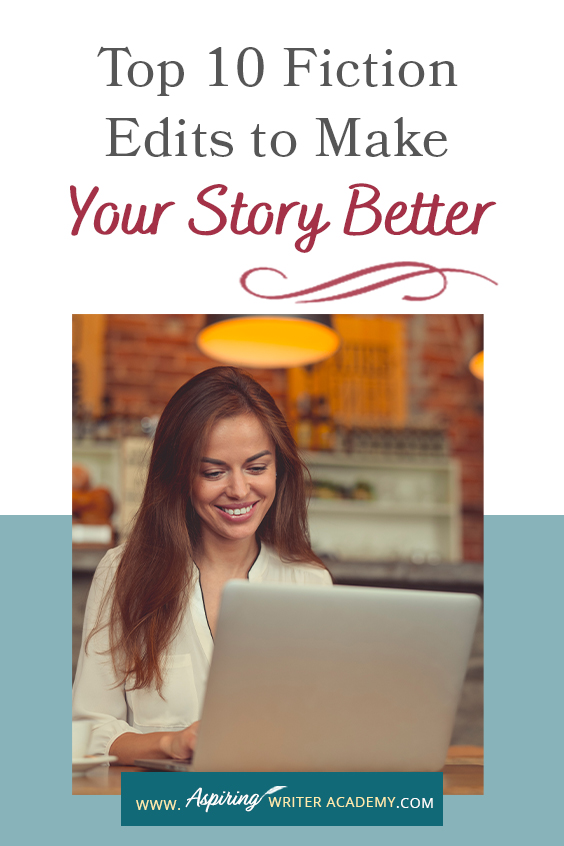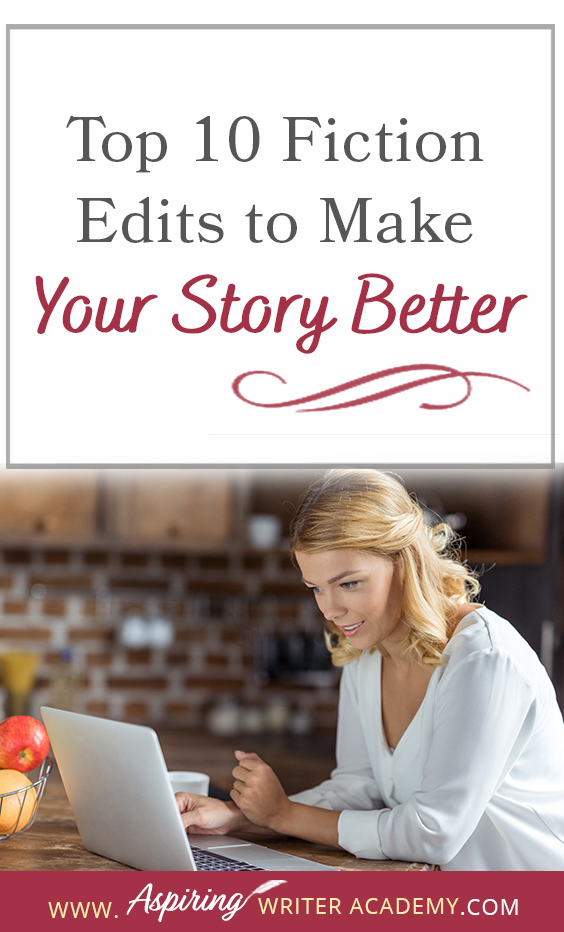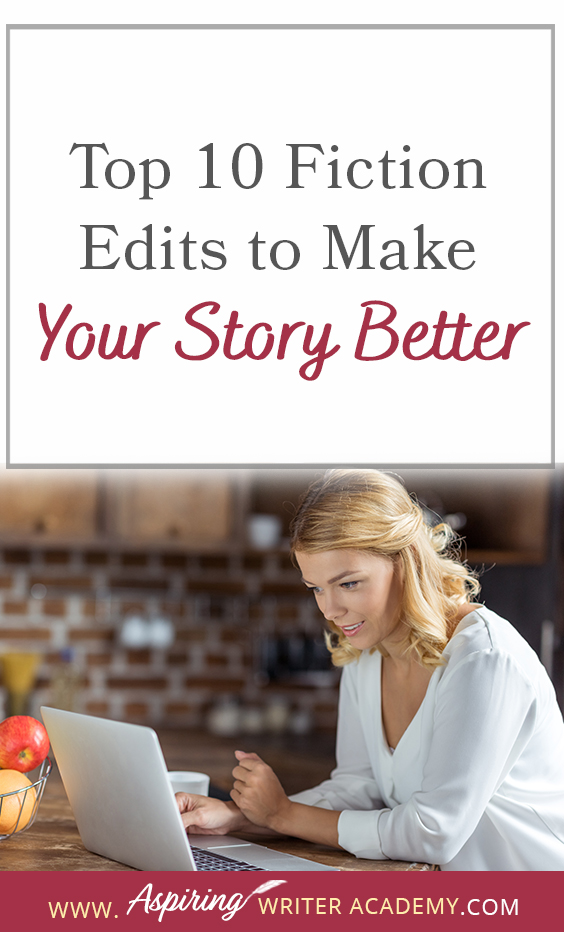Top 10 Fiction Edits to Make Your Story Better
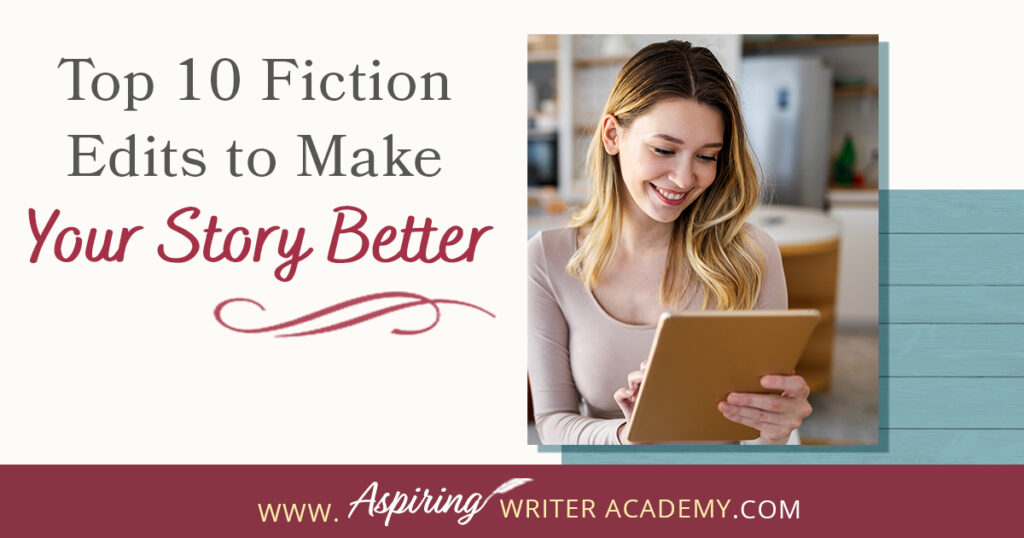
Are you searching for simple editing tips to elevate your fictional novel from good to great? Do you wish you had a checklist to guide you through the process? If you're new to self-editing and don't know where to begin, we've got you covered.
In our post, Top 10 Fiction Edits to Make Your Story Better, we delve into the ten most effective edits that will help transform your writing, creating a novel that is strong, concise, and captivating to your readers.
Whenever I attend writer conferences and ask newer authors what they need to learn to create a better story, the answer is often, “when first starting out, you don’t know what you don’t know.” It is only with experience and information gleaned from others that we realize how far we’ve come on our writing journey. And that there is always so much more to learn.
Today we will be identifying the top 10 fiction edits to make your story better. While you might find other comprehensive lists worth considering, let’s not make the process overwhelming.
Let’s just start with the top 10 listed below.

1) Cut the number of times you use the word ‘it’ – especially on the first page!
Print out the first five pages of your manuscript. Your mind looks at your story differently when the text is printed out. You will see mistakes that you didn’t catch when looking at the words on a computer screen.
Now take a red pen and circle how many times you have used the word ‘it’ on the first page. If you notice that you have dozens of ‘it’ circled, then you have not been specific enough with your word choices. You need to explain to the reader what ‘it’ is.
Example:
She thought the story she told her friend was very good. It wasn’t an exact lie, but it got her out of trouble for not showing up on time. It wasn’t as if she was always late. But it sure looked like it when you added up all the times she’d been waylaid by unforeseen circumstances. Anyhow, her friend seemed to take it well. As long as she didn’t do it again. At least anytime soon, or it would lead to trouble between them for sure!
There are 8 highlighted uses of the word ‘it’ in one paragraph. The first line reveals to the reader what ‘it’ is, but instead of repeating the same word again and again, name what ‘it’ is using a synonym or a more specific word choice that offers a better visual or understanding of what is going on. Remind the reader – what is ‘it’?
Revised Example:
She thought the story she told her friend was very good. The excuse wasn’t an exact lie, but the exaggerated truth got her out of trouble for not showing up on time. She wasn’t as if she was always late. But her tardiness sure looked like bad when you added up all the times she’d been waylaid by unforeseen circumstances. Anyhow, her friend seemed to take the news well. As long as she didn’t do it wasn’t late again. At least anytime soon, or her fictitious explanations would lead to trouble between them for sure!
By replacing ‘it’ with specific word choices and revising the sentences a little, we eliminated every ‘it’ in the paragraph. Now we don’t want our sentences to sound silly, so if the best word to use is the word ‘it’ then you can choose to leave in a few, but no more than 3 on the first full page! Now continue to circle ‘it’ on the next few pages and see how many you can eliminate.

2) Cut the adverbs.
Many adverbs are created by adding “-ly” to an adjective. (soft / softly)
But not all “-ly” words are adverbs. (‘Family’ is a noun.)
And not all adverbs end in ‘-ly.’ (often, never, very, quite, now, soon, far, fast, well)
An adverb is a word that modifies, describes, or improves a verb, adjective, or another adverb and tells how, where, when, the degree of intensity, quality, or how much or how often something is done.
The main point is that too many adverbs in a story can clutter the narrative and lead to weaker sentences. An abundance of ‘-ly’ words can also quickly bore the reader. The solution is to use stronger verbs and adjectives that do not need additional description.
Take out your first 5 pages again and circle all the ‘-ly’ adverbs with a blue pen. These are words like:
Loudly
Quickly
Highly
Purposefully
Thoughtfully
Tactfully
Hastily
Closely
Quietly
Peacefully
Easily
Extremely
Absolutely
Frequently
Rarely
Readily
Now consider how you might use a stronger verb, or descriptors in your sentences so that the adverb is not needed.
Example:
She walked quickly to the car. (Quickly is the adverb describing how she walked.)
Better:
She raced to the car, her feet pounding the pavement. (‘Raced’ is a stronger, more visual verb than walked.)
Another Example:
The eleven-mile round trip hike made him extremely hungry. (The adverb ‘extremely’ describes how hungry he is when a single stronger adjective would have sufficed.)
Better:
The eleven-mile round trip hike left him famished. (or ravenous for food.)
When looking at just one sentence, including an ‘-ly’ adverb doesn’t seem so bad, but when you have a paragraph that reads something like this:
She walked quickly to the car and fervently drank from her water bottle. She looked over at her partner who was extremely hungry after the eleven-mile round trip hike. He speedily pulled out a granola bar and hastily ripped off the packaging before shoving the whole thing in his mouth greedily. Slowly, he gave her a sheepish grin, as if belatedly realizing he should have thoughtfully offered her a bite. “It’s ok,” she said, nonchalantly. “I have my own.”
As you can see, the repetition of the ‘-ly’ words is a bit much. Especially when used repeatedly in dialogue to describe how a person is speaking.
Example:
“Give me the truth now,” he said, harshly (or loudly, bitterly). The adverb tells how he said it.
Better:
“Give me the truth now,” he demanded (or insisted or grumbled). The stronger verb tells how he said it without an additional -ly descriptor.

3) Make sure pronouns (he/she/they) refer back to the last person or group of people named.
When pronouns are not used properly in a paragraph, readers can become confused and they might not know who the pronoun refers to.
Example:
Her friend would be angry if she knew what she had done to her science project behind her back.
Or
She would never know the difference if she switched her purse with the one she bought for her daughter for her birthday. (In this sentence the pronouns ‘she’ and ‘her’ can refer to 3 different people!)
The pronoun in a sentence always refers back to the last person named. If the pronoun refers to someone else, then you need to revise the sentence or name the new person the pronoun refers to.
Example:
Susan realized her friend would be angry if she knew what had been done to her science project behind her back. (Now all the pronouns belong to the last person identified – the friend. Another sentence can inform the reader that the culprit was Susan.)
Second Example:
Carol would never know the difference if Jan switched Carol’s drink with the one Jan bought her daughter for her birthday. (By replacing the pronouns for names, it is clear who is who and by deleting ‘for’ before ‘her daughter’ it is clear that the daughter is Jan’s.)
Even better is to revise the sentence to keep the references to each person together.
If Jan switched the drink she bought for her daughter’s birthday with Carol’s, she would never know the difference.

4) Replace passive verbs with active.
Whenever you see a passive ‘to be’ verb, such as ‘was going,’ it should be changed to a verb that is active such as he ‘went.’ This makes your manuscript much stronger.
Examples:
- He ‘is thinking’ – change to ‘he thinks.’
- She ‘was skipping’ out the door – change to ‘she skipped’ out the door.
- They ‘were clapping’ when the show ended. Change to ‘They clapped.’
- She ‘started swimming’ toward the shore. Change to ‘She swam toward the shore.’
- I ‘am going’ to write a paper on elves. Change to ‘I will write a paper on elves.’
- We ‘are singing’ in the choir festival. Change to ‘We will sing in the choir festival.’
- She’s ‘been weeding’ the garden all day. Change to ‘She weeded the garden all day.’
- I must ‘be off’ on my walk. Change to ‘I must go on my walk.’
- He ‘is being’ helpful. Change to ‘He helps.’
Look for verbs ending in ‘ing’ preceded by ‘is, was, were, am, are, be, being, and been’ and replace with direct verbs ending in ‘ed’ or a simple single word choice.

5) Cut dialogue tags whenever possible and replace with an action beat or POV thought.
Too many dialogue tags like ‘he said/she said’ can clutter a manuscript and slow down the action.
Cut as many as you can by placing a short action performed by the character in front of his dialogue (or directly after) so the reader knows the dialogue belongs to him.
Example:
Instead of: “Do you want to go to the carnival?” he asked hopefully.
Try this: He gave her a sidelong look, his eyes filled with hope. “Do you want to go to the carnival?”
Or
“Do you want to go to the carnival?” He gave her a sidelong look, his eyes filled with hope.
Likewise, you can also delete a POV (point-of-view) character’s dialogue tag and replace it with a line of his/her direct internal thought.
Example:
Would she agree to accompany him? He hoped so, but she’d been distant these past few days. The only way to find out was to ask. “Do you want to go to the carnival?”
After a back-and-forth exchange is established (each speaker starts a new indented paragraph) you can just have each character’s dialogue. But after several lines it is a good idea to include an action beat or a line in the main character’s internal POV to remind the character who is speaking.
You can also add lines of description in the main character’s POV before their dialogue to remind the reader who is speaking.
Example:
She eyed the intricate light blue scrollwork pattern on the outside of the vase and nodded in appreciation. “An antique?”

6) Start a new paragraph for each new speaker in dialogue.
You cannot have two people speaking in the same paragraph or it becomes confusing. Also keep each character’s actions and thoughts with their own dialogue and do not combine their action/thoughts with another character’s.
Wrong:
He put his hand on the young woman’s shoulder, hoping to offer her a small measure of comfort. “Do you want to talk about it?” he asked, but she shook her head. “No, I don’t,” she replied. He could only wonder why but kept silent. It wouldn’t do any good to pry into her private affairs if she didn’t want him to.
Right:
He put his hand on the young woman’s shoulder, hoping to offer her a small measure of comfort. “Do you want to talk about it?”
She shook her head. “No, I don’t,” she replied.
He could only wonder why but kept silent. It wouldn’t do any good to pry into her private affairs if she didn’t want him to.

7) Careful that you do not switch tense.
Re-read over each paragraph and make sure you do not have any sentences that suddenly switch from third person past tense to present tense, or you will throw off the reader. (Or switch from first person present tense to third person or any other tense.)
The only time this is acceptable is when the main character has a direct thought, and it would be italicized to indicate that it is a direct thought.
Example:
She turned on the stereo and danced to the sway of the music. She loved this particular band, loved how each of their songs touched her emotions. As the next song began to play, she made a decision. Tomorrow, I’m going to buy their new album.

8) Do not switch POV in the middle of a scene.
In older books, you might find a lot of ‘head-hopping.’ This is when you start a scene in one character’s POV (point-of-view), then jump into another person’s POV, and maybe even a third person’s POV.
But this can be confusing to the reader, and today most publishers and readers expect you to stay in one character’s POV per scene. Do not switch to another character’s POV until the following scene.
You might not be able to reveal other characters internal thoughts during your main POV character’s scene, but you can convey what these other characters are thinking and feeling through their body language, their actions, and their dialogue.
Staying in one character’s POV per scene allows the reader to bond with and understand that character on a deeper level. The reader needs to know who to root for, who to follow.

9) Use a comma after dialogue before using a tag, not a period! And use lower-case to start the tag.
This is a common mistake I see again and again when editing other writer’s manuscripts.
Many times an author will put a period after dialogue when it should be a comma, attaching the dialogue tag.
Wrong:
“I love the warmth of the sunshine.” She exclaimed.
Right:
“I love the warmth of the sunshine,” she exclaimed.
If the dialogue did not have a dialogue tag telling how the line was said, then the dialogue would end with a period. But any time you have a tag after telling the reader how the dialogue was said, you need to end the dialogue with a comma and attach the tag (which starts in lower case lettering because it is a part of the sentence.)
If your dialogue ends with a question mark or exclamation point, then the dialogue tag after still starts with a lower-case letter.
Wrong:
“Can you help me water the plants?” She asked.
Right:
“Can you help me water the plants?” she asked.

10) Include the 5 senses in each scene.
Try your best to include the 5 senses in each scene or as many as possible. Try for at least 3. This allows the reader to experience the scene in greater detail and depth. The 5 senses bring the scene alive especially when you are in the main character’s POV (point-of-view.)
Sight —what does your character see through their eyes in this scene? What do they focus on? What little details catch the character’s attention and why?
Hear —what does your POV hear? Or does another character in the scene say they heard something? How does it sound? Describe the volume, quality, pitch, etc.
Smell —what does your character smell in this scene? The steaming robust scent of fresh-brewed coffee? Or the sweet smell of a flower? Or the spicey aroma of a Mexican dish?
Taste —what does your character taste in this scene? Does your character taste a sour grape? A tangy piece of candy? Or is the reference to taste more an association such as ‘the bitter taste of disappointment soured his stomach and diminished his appetite.’
Touch —what can your character touch or feel? The chill of the wind on her face? The heat blasting from the furnace? The course texture of the blanket she is lying on? The soft fur of a rabbit? The gritty sand stuck to her ankles after a day at the beach? The silky feel of new bed sheets?
Do not include all five senses in your fictional novel if it doesn’t fit the scene. Their inclusion should appear natural and not forced. If you can realistically only include three of the 5 senses in the scene or on rare occasions, only two, then do what best fits the scene.
Take out those first 5 pages again and circle each use of the 5 senses. How can you rewrite to include more? As you revise your finished manuscript, always check for the inclusion of the 5 senses (or as many as you can) in every scene.
Happy editing!
We hope you have found Top 10 Fiction Edits to Make Your Story Better a useful tool to revise your fictional novel and take your writing from good to great!
If you have any questions or would like to leave a comment below, we would love to hear from you!

If you like more help developing your story, you may wish to download our Free Brainstorming Your Story Idea Worksheet
Do you find it difficult to create compelling antagonists and villains for your stories? Do your villains feel cartoonish and unbelievable? Do they lack motivation or a specific game plan? Discover the secrets to crafting villains that will stick with your readers long after they finish your story, with our How to Create Antagonists & Villains Workbook.
This 32-page instructional workbook is packed with valuable fill-in-the-blank templates and practical advice to help you create memorable and effective antagonists and villains. Whether you're a seasoned writer or just starting out, this workbook will take your writing to the next level.
We Believe All Authors Can Aspire to Take Their Writing to the Next Level!
Our Goal for Aspiring Writer Academy is to help people learn how to write quality fiction, teach them to publish and promote their work, and to give them the necessary tools to pursue a writing career.

ENTER YOUR EMAIL BELOW
TO GET YOUR FREE
"Brainstorming Your Story Idea Worksheet"
7 easy fill-in-the-blank pages,
+ 2 bonus pages filled with additional story examples.
A valuable tool to develop story plots again and again.
Other Blog Posts You May Like
How to Use Framing Techniques in Your Fictional Novel
How to Delete Dialogue Tags (He said /She said) in Fiction Writing
How to Manipulate Pacing to Increase the Intensity of Your Scenes in a Fictional Novel
Fiction Writing: The 3 Different Levels of Editing
5 Reasons Your Writing Sucks! (And How to Fix It)
Novel Writing Tips: Don’t Bury the Dialogue!
Fiction Writing: Critique Group Etiquette & Warning Signs of a Good Group Gone Bad
Fiction Writing: How to Find a Critique Partner/Group
Creative Writing: 5 Ways to Strengthen a Weak Fictional Character

is a multi-published author, speaker, and writing coach. She writes sweet contemporary, inspirational, and historical romance and loves teaching aspiring writers how to write quality fiction. Read her inspiring story of how she published her first book and launched a successful writing career.

